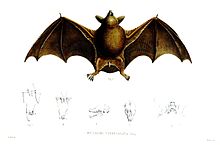Mystacinidae
| Mystacinidae Temporal range: Miocene to Recent 20–recent Ma |
|
|---|---|
 |
|
| New Zealand lesser short-tailed bat, Mystacina tuberculata | |
| Scientific classification | |
| Kingdom: | Animalia |
| Phylum: | Chordata |
| Class: | Mammalia |
| Order: | Chiroptera |
| Suborder: | Microchiroptera |
| Superfamily: | Noctilionoidea |
| Family: |
Mystacinidae Dobson, 1875 |
| Genus: |
Mystacina Gray in Dieffenbach, 1843 |
| Type species | |
|
Mystacina tuberculata Gray, 1843 |
|
| Species | |
Mystacinidae is a family of unusual bats, the New Zealand short-tailed bats. There is one living genus, Mystacina, with two recently extant species, one of which is believed to have become extinct in the 1960s. They are medium-sized bats, about 6 centimetres (2.4 in) in length, with grey, velvety fur.
The family also contains the extinct genus Icarops known from Oligocene and Miocene fossils found in Australia, as well as several fossils from the contemporary Saint Bathans Fauna in New Zealand. The oldest unambiguous fossils of the living genus date to the late Pleistocene of New Zealand, though the aforementioned Saint Bathans species may also belong to the genus.
Mystacines appear to have been an old gondwannan lineage; they diverged from other bat groups within Noctilionoidea (a primarily gondwannan group otherwise including Noctilionidae, Phyllostomidae and Mormoopidae) around 51-41 million years ago.
Mystacinids are the most "un-batlike" family of bats. They spend much of the time on the ground, instead of flying, and are unique in having the ability to fold their wings into a leathery membrane when not in use. Another distinctive feature of the group is an additional projection on some of the claws, which may aid in digging or climbing. They are omnivorous, eating fruit and carrion in addition to ground-dwelling arthropods. They also eat pollen and nectar, which they are able to collect with their extensible tongues. They sometimes chew out burrows in rotting wood, but can also roost in rock crevices or the burrows of seabirds.
Many old sources refer to the terrestriality of these bats as a trait acquired due to island endemism, assumed to have evolved due to the absence of terrestrial mammals in New Zealand. However, Icarops, a mainland Australian genus, shows adaptations to terrestriality, suggesting that it evolved prior to the colonisation of New Zealand, in an environment dominated by terrestrial mammals such as marsupials and monotremes. Furthermore, the Saint Bathans fossil species co-existed with the Saint Bathans mammal, suggesting that New Zealand wasn't devoid of land mammals when these bats first arrived.
...
Wikipedia
